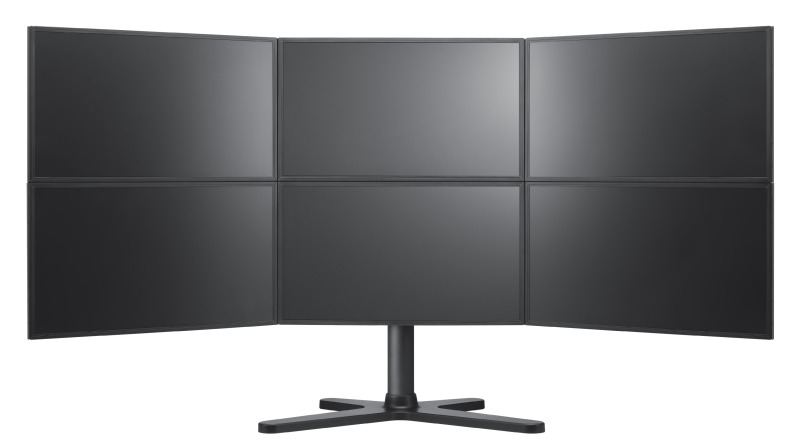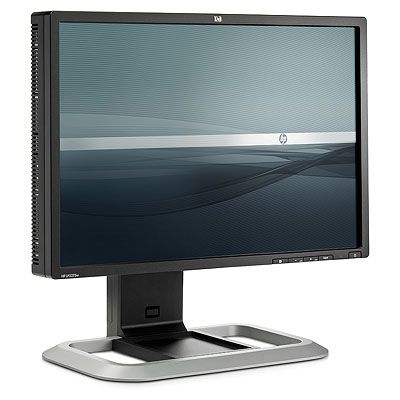Part 2: AMD's Eyefinity Technology Explained
The Case For DisplayPort, Continued, And Bezels
Of course, there are other reasons to justify a higher price tag for a DisplayPort monitor. One is the age-old “future-proofing” argument. We always feel a bit lame and dirty suggesting this, but in the case of DisplayPort, the argument seems sound. We don’t see a reason why the market won’t standardize on DisplayPort, so buying into legacy formats makes less and less sense, especially if you can take advantage of special sales that get pricing close to that of non-DP equivalents.
“Graphics cards are getting DP connectors now and they’re going to have them in the future,” says AMD’s Bruce Gasson. “The industry has converged on this plan to get rid of VGA and DVI as the de facto connectors. Really, the reasons are the unique features DisplayPort has over DVI and one of them is bandwidth.”
Even if Dual-Link DVI featured twice as many pins as it presently has, it wouldn’t match the bandwidth of DisplayPort 1.2, the new spec finalized in December 2009. Apart from being able to carry ultra-high resolutions, DisplayPort can also carry high bitrate 7.1 surround audio, touchscreen data, and bi-directional USB signals. Gasson notes that the logic in DisplayPort allows it to “easily switch between high-res, high color depth, and high refresh rate. These are the features that future monitors will want to have.”
DisplayPort 1.2 doubles the data rate of 1.1a from 10.8 Gb/s to 21.6 Gb/s. What can you do with all of this bandwidth? For starters, you can go from supporting a single 2560x1600 monitor under 1.1a to two 2560x1600 or four 1920x1200 panels. These aren’t cloned screens, either, because DisplayPort 1.2 supports multi-streaming, allowing each screen to get its own data feed via daisy chaining though a prior monitor in the series. Alternatively, you should soon find DisplayPort 1.2 hubs able to output multiple DP 1.1 streams. Moreover, DisplayPort finally has the bandwidth needed to support stereoscopic 3D displays.
Currently, the DisplayPort.org site lists Apple (specifically the 24" LED Cinema Display), Dell, Eizo Nanao, HP, Lenovo, and NEC as DisplayPort monitor vendors. We know that others are coming, including Samsung—a very strange omission from the list given that Samsung created the industry’s first DisplayPort LCD (30 inches!) back in mid-2007 and has been working with AMD on promoting six-screen Eyefinity arrays. Unfortunately, monitor vendors don’t appear to distinguish DisplayPort 1.1 from 1.2 in their specifications, so be careful going forward and try to identify 1.2-ready models.
Incredibly, as of this writing, Newegg appears to carry only one DisplayPort monitor (HP’s LP2275). Amazon lists 13 models through third-party partner sites, the cheapest of which (new) is Dell’s 22" P2210H for $220.42. In contrast, Amazon shows a total of 1,688 new monitor models available. DisplayPort clearly has a long, uphill road ahead on its way to market dominance.
Framing The Bezel Issue
Get Tom's Hardware's best news and in-depth reviews, straight to your inbox.
Even just reading the forum posts on our last Eyefinity feature, it’s clear that one of people’s top concerns about Eyefinity is monitor bezels. If the ideal goal of Eyefinity is to create a “holodeck” experience, you can’t very well achieve the illusion of edge-to-edge reality with bezels cutting through your field of view.
This is true...to a point. Consider looking out a wide set of living room windows or being in the front seat of a car. In both cases, you have support bars, little blind spots, running through the glass. Nobody stands around saying, “Man, if only I didn’t have these frames around my living room window panes!” They’ve always been there and probably always will be. That’s life. If you want to see what’s behind them, you move your head a few inches.
Is there any hope of ever seeing bezel-free desktop displays? Probably no time soon. Eliminating bezels has been a long-time priority in the digital signage market, but it’s never been demanded much by consumers. Even if the public demanded it, monitor manufacturers (or their suppliers) would have to retool the moldings for their designs, something they’d no doubt resist unless absolutely necessary. Instead, vendors are focusing on attributes such as LED backlighting and thinner overall design, which are more likely to spur sales.
Creating a validated monitor program for Eyefinity is much more complex than for dongles. It’s more than just a matter of, “well, does it work or not?” No doubt, AMD would love to specify a 3mm bezel width for its still-not-finalized Eyefinity Validated program. But if you throw a party at a time when no one can show up, you’re going to have a really small attendance list. AMD can’t mandate the impossible without committing market suicide. As it is, Bruce Gasson notes that the Ready portion of the monitor program will probably specify 15mm bezels while the Validated side will go to 10mm. Additional specs will likely include 5ms access times and “very attainable brightness levels.” The goal is to make it easy for vendors to qualify.
Current page: The Case For DisplayPort, Continued, And Bezels
Prev Page Panels Next Page Bezel Compensation-
akula2 I use 3 LCDs with 5770 as well as 5850 cards to run many applications simultaneously. Eyefinity feature offers so much and one could easily avoid buying additional PCs by tapping the features from the processor and the graphics card.Reply -
ckim2116 It'd be nice if AMD had their own list of Eyefinity supported games. Some of the games on WGF don't work; in fact, the only games that have worked out perfectly for me have been TF2, Batman Arkham Asylum, Torchlight, and L4D2 (all you have to do is select your resolution in the options, in my case 5760x1080). In other games the menu screen just keeps blinking, and attempting to change the resolution just freezes the game.Reply
Can't wait until all the kinks are worked out! -
cangelini akula2Could someone tell me what happened to the "Print" feature on Tom?Reply
It's right above the comments section, to the right of "Share," amongst a ton of tiny little icons :) -
jsowoc I don't see DisplayPort costing that much more. If I look at 22-24" LCDs, the cheapest they come is around $200 for a TN panel or $300 for a PVA monitor, and about $450-500 for an IPS monitor. It's personal preference whether the quality difference is worth the cost.Reply
If you compare a $200 TN w/out DisplayPort to a $500 IPS w/ DisplayPort, you are comparing apples to oranges. The Amazon price of $220 for a TN w/ DisplayPort is more representative of pricing. -
xrodney I am using 30" dell but only way i can use its native resolution is over DVI, on either HDMI or Displayport maximum of 1920x1200 is possible.Reply
I am not sure if this is limit on DELL only, but as far as I read neither ati 4xxx or 5xxx grapahic card and neither any widely available LCD supports more then that which is quite pitty.
Even more disapointing is that DHCP working only over single DVI link (1920x1200 max) on DELLs and probably others as well. -
1898 Very interesting read, thanks.Reply
ckim2116
From the article: http://support.amd.com/us/eyefinity/Pages/eyefinity-software.aspx -
RazberyBandit Hmm. Landscape-landscape-landscape seems like it would just be sick for gaming. ASUS monitor bezels are actually angled at the top and bottom. When stacked tightly in such an arrangement, they actually wrap around the viewer nicely. Three 24" 16:9 ratio (1920x1080) monitors stacked sideways yields a HUGE 3:2 ratio (3240x1920 resolution) display. Three 16:10 (1920x1200) monitors end up at 3600x1920. I like this idea better than the far more panoramic view of 5760x1080 or 5760x1200 for most games.Reply
Alas, I'll be waiting on the next-gen cards and monitors in hopes that prices drop and availability increases. I'd also like to see the proposed standards mentioned within this article actually go into effect, as well as see adoption of display port grow and the technology itself mature.
Lastly I hope stands adopt a standard that supports landscape-landscape-landscape, portrait-portrait-portrait, and any combination in-between. Having to go out and buy 3 cheap VESA mounts, some metal tubing and round-bar, then get to cutting, bending, and welding my own stand together sounds like a fun project, but I'd rather just buy a mass-produced one.
Edit: I meant portrait-portrait-portrait... -
gaborbarla Bought a 5870 HD the other day.Reply
Two questions remain for me that I couldnt filter out from these articles by skimming through them:
1. Why do we need a display port again? I thought the whole point of HDMI was to introduce a digital standard that works with everything TVs Digital signal processors, PCs. Now that most monitors, graphics cards and even some motherboards are starting to support HDMI they come out with a new format... (dot dot dot)
2. Why does the 5800 series need a display port? why couldn't it have 3 DVI-Ds? So far I haven't even seen a single monitor that has displayport.

